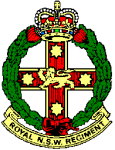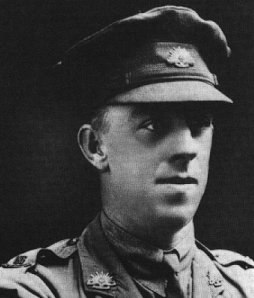1st Battalion, 1st Brigade, 1st Division
GEORGE JULIAN HOWELL was born at Enfield, New South Wales, on 19 November 1893, to Francis John and Martha Howell. Educated at the Croydon Park and Burwood Public Schools, he took up bricklaying and later became a builder in the Enfield area of Sydney.
On enlistment in the AIF on 3 June 1915 2445 Private Howell was allotted to the 7th Reinforcements of 1st Australian Infantry Battalion which departed for service overseas on 14 July 1915 aboard A67 HMAT Orsova. Private Howell was taken on strength of 1st Battalion at Gallipoli on 1 November 1915.
After the AIF evacuation from Gallipoli and further training in Egypt 1st Battalion departed Egypt for service on the Western Front in March 1916.
During the fighting at Pozières in July 1916 Private Howell was WIA and evacuated to a hospital in Sheffield in England. After recovering from his wounds and attending a training school he returned to 1st Battalion on 26 November 1916 and was appointed a Lance Corporal on 10 December 1916 then promoted to Corporal on 6 February 1917.
For his gallantry during the 1st Battalion operations at Demicourt on 9 April 1917 he was awarded a Military Medal. The initial recommendation read:
At Demicourt on 9th April 1917 for courage and devotion to duty displayed while leading his rifle bombing section in the operation against the German position. On several occasions when held up by machine gun fire he overcame the opposition by sound offensive tactics and good use of his weapons and continued the advance. He, with his section, was in the lead throughout and was of great assistance to his Company in the capture of its objective.
Barely four weeks later on 3rd May 1917 fourteen divisions, including the 2nd Australian Division, attacked the Hindenburg line commencing what became known as the Second Battle of Bullecourt. Within the Second Division area of operations, a deep re-entrant between the villages of Bullecourt and Queant, 6th Australian Brigade on the left was able to take and hold their objectives while 5th Brigade struggled to reach and hold the OG1 trench line the first of three lines of German trenches. During the next few days more troops, including 1st Division, were brought forward to hold and extend the gains made on the 3rd of May. When the Germans launched a general counter-attack on the 6th May they used flame-throwers, which caused the 3rd Brigade to withdraw from its trenches. At 6:00am Corporal Howell notified Battalion Headquarters that the Battalion to his right was retiring. The 1st Battalion commander then hurriedly organized a group to resist the enemy assault and a fierce bombing fight ensued. Corporal Howell, fearing that the enemy would outflank his battalion, climbed on to the top of the parapet and bombed the enemy, forcing them back along the trench. When his bombs ran out Howell continued to pursue the enemy with his bayonet but as he was exposed to heavy bomb and rifle fire it was not long before he was severely wounded. In the interval, the withdrawing battalions rallied and a party from 1st Battalion succeeded in reclaiming the ground lost to the enemy earlier.
For his actions on 6 May 1917 Corporal George Julian Howell MM was awarded a Victoria Cross. The initial recommendation reads:
For gallantry, fearlessness and initiative on 6th May 1917 in trench OG1 near Bullecourt, France, part of which his Battalion was holding. The enemy attacked the Battalion which was occupying the trench on our right and succeeded in driving them from the trench and were approaching our right flank. Corporal Howell seeing this, without orders, immediately jumped up on the parapet and then singlehanded, though subjected to heavy bomb and rifle fire, threw bombs at the enemy and advanced on them at the same time. Having exhausted his supply of bombs he advanced along the top of the parapet and attacked the enemy with his bayonet until he fell wounded into the trench. Seeing Howell’s action other men had come forward to support him and the enemy were finally driven out of the trench which was again occupied and held, being taken over later by the Battalion which had formerly occupied it. Howell’s action in stemming the tide of advance of the enemy and forcing them to draw back enabled the organisation of the counter attack which was immediately launched and drove the Germans from the position. His action was witnessed not only by the whole of his Battalion but also by the Battalion occupying OG 2. Apart from its great value tactically, his example had a great effect in inspiring other men and undoubtedly was greatly responsible for the enemy being driven back immediately, though it was some time before they were driven out of the whole position. Furthermore the bravery of Corporal Howell on the above occasion has been the topic of conversation in this and neighbouring Battalions of the Brigade, both Officers and Other Ranks. He has done previous good work and has already been awarded a Military Medal. His wound has proved a very serious one.
Badly wounded and suffering from at least 28 separate wounds Corporal Howell was evacuated to England for prolonged hospitalisation in Norfolk and Norwich in England. Sufficiently recovered from his wounds he was invested with his Victoria Cross and Military Medal by King George V at Buckingham Palace on 21 July 1917 and was later promoted to Sergeant.
Howell’s multiple wounds necessitated further and prolonged hospital treatment. He returned to Australia in October 1917 and was discharged on 5 June 1918. On 1 March 1919 he married a nurse, Sadie Lillian Yates, at St Stephen’s Presbyterian Church, Sydney, and they settled at Coogee. He joined the advertising staff of Smiths Newspapers and later worked for the Bulletin Newspaper Company. By 1933 he was New South Wales representative for the Brisbane Standard and the Queensland Worker newspapers.
During the Second World War Howell served as an army staff sergeant at Eastern Command Headquarters, Paddington. In August 1944 he joined the United States Sea Transport Service and participated in the American invasion of Leyte at the commencement of the Philippines campaign.
In December 1953 Howell moved from New South Wales to Western Australia, and settled in Applecross, a suburb of Perth and later moved to Gunyidi near Watheroo. In 1956 he travelled with the Australian VC contingent to London to take part in the Victoria Cross Centenary Celebrations.
George Julian Howell died at the Repatriation General Hospital, Perth, Western Australia on 24 December 1964. He was cremated at Karrakatta crematorium and a plaque was placed in the Western Australian Garden of Remembrance. A soldier’s club bearing his name was opened at Randwick.
Sergeant George Julian Howell’s Victoria Cross is held at the Australian War Memorial, Canberra, ACT.

